加密方法 ToEncrypt()
解密方法 ToDecrypt()
借鉴于 C#对字符串进行加密解密 - 明志德道 - 博客园 (cnblogs.com)
成果展示

主要代码展示
using System.Security.Cryptography;
using System.Text;
namespace WinFormsApp1
{
public partial class Form1 : Form
{
public Form1()
{
InitializeComponent();
}
private void button1_Click(object sender, EventArgs e)
{
if (textBox2.Text.Length == 4)
{
try
{
textBox3.Text = new Encrypt().ToEncrypt(textBox2.Text, textBox1.Text);
}
catch (Exception ex)
{
MessageBox.Show(ex.Message);
}
}
else
{
MessageBox.Show("密钥长度不符!", "提示");//提示用户输入密钥长度不正确
}
}
internal class Encrypt
{
public string ToEncrypt(string encryptKey, string str)
{
try
{
byte[] P_byte_key = Encoding.Unicode.GetBytes(encryptKey);
byte[] P_byte_data = Encoding.Unicode.GetBytes(str);
using (MemoryStream P_Stream_MS = new MemoryStream())
{
using (CryptoStream P_CryptStream_Stream = new CryptoStream(P_Stream_MS, new DESCryptoServiceProvider().CreateEncryptor(P_byte_key, P_byte_key), CryptoStreamMode.Write))
{
P_CryptStream_Stream.Write(P_byte_data, 0, P_byte_data.Length);
P_CryptStream_Stream.FlushFinalBlock();
byte[] P_bt_temp = P_Stream_MS.ToArray();
return Convert.ToBase64String(P_bt_temp);
}
}
}
catch (CryptographicException ce)
{
throw new Exception(ce.Message);
}
}
public string ToDecrypt(string encryptKey, string str)
{
try
{
byte[] P_byte_key = Encoding.Unicode.GetBytes(encryptKey);
byte[] P_byte_data = Convert.FromBase64String(str);
using (MemoryStream P_Stream_MS = new MemoryStream(P_byte_data))
{
using (CryptoStream P_CryptStream_Stream = new CryptoStream(P_Stream_MS, new DESCryptoServiceProvider().CreateDecryptor(P_byte_key, P_byte_key), CryptoStreamMode.Read))
{
byte[] P_bt_temp = new byte[200];
using (MemoryStream P_MemoryStream_temp = new MemoryStream())
{
int i = 0;
while ((i = P_CryptStream_Stream.Read(P_bt_temp, 0, P_bt_temp.Length)) > 0)
{
P_MemoryStream_temp.Write(P_bt_temp, 0, i);
}
return Encoding.Unicode.GetString(P_MemoryStream_temp.ToArray());
}
}
}
}
catch (CryptographicException ce)
{
throw new Exception(ce.Message);
}
}
}
private void button2_Click(object sender, EventArgs e)
{
if (textBox5.Text.Length == 4)
{
try
{
textBox4.Text = new Encrypt().ToDecrypt(textBox5.Text, textBox6.Text);
}
catch (Exception ex)
{
MessageBox.Show(ex.Message);
}
}
}
}
}